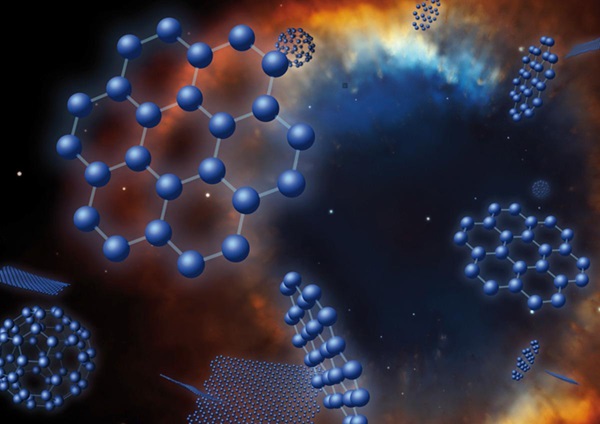Raman spectroscopy investigations of carbonaceous CV3 chondrites, Allende and QUE 94366 meteorites reveal the presence of nanoscale graphene in highly refractory mineral settings. A research team led by an ELSI affiliated scientist has found the graphene embedded in calcium-aluminium-rich inclusions that are considered among the oldest minerals native to the solar system. The detection can be of immense significance in the light of analyses of samples returned from JAXA Hayabusa-2 spacecraft, samples incoming from NASA OSIRIS-REx spacecraft and future missions to asteroids and comets.

Laboratory-based investigations have revealed the presence of nanoscale graphene in two carbonaceous meteorites, Allende and QUE 94366. Scientists from Earth-Life Science Institute (ELSI) at Tokyo Institute of Technology, Earth and Planets Laboratory (erstwhile Geophysical Laboratory) at Carnegie Institution for Science and the Astromaterials Research and Exploration Science Division, NASA Johnson Space Center investigated the two meteorites using Confocal Raman Imaging Spectroscopy. Raman spectroscopy is the best-suited technique for structural and compositional analyses of carbon materials. It was used in the study to reveal the presence of graphene along the rims of calcium-aluminium-rich inclusions (CAIs), present in the mineral matrices of the two meteorites, and independent of graphite, which is the higher-order three-dimensional structure formed from stacking of two-dimensional graphene. These results are significant in the backdrop of the ongoing sample-return missions to carbonaceous asteroids, particularly JAXA’s Hayabusa-2 that has returned samples from asteroid Ryugu and NASA’s OSIRIS-REx mission that will return samples from asteroid Bennu in 2023.
Astronomical telescopes in planetary nebulae have identified graphene. Moreover, its presence has been closely identified with graphitic structures present in many meteorites. Nevertheless, this study is the first-of-its-kind diagnosis of graphene, independent of graphite, within two different extraterrestrial fragments, each with a different formation and history in outer space. Over the years, peer-reviewed studies have concluded CAIs to be among the first solids to have condensed in the solar system. They are known to be condensed in extremely high-temperature zones of the inner solar nebula much before the formation of planets. Graphene’s presence within the CAI rims suggests its possible synthesis contemporaneously with the condensation of CAIs approximately 4.5 billion years ago.
The search for graphene in CAI-containing sections of Allende and QUE 94366 was not serendipitous. Chaitanya Giri (ELSI), Andrew Steele (Earth and Planets Laboratory, Carnegie Institution), and Marc Fries (NASA JSC) were revisiting the same meteoritic sections that demonstrated the presence of graphite whiskers in a separate study done in 2008 (Fries & Steele, Science, 2008). This study anticipates that the graphene could be the two-dimensional building block of the three-dimensional graphite whisker, similar to a rolled-up sheet of paper that is pulled thin on one end.
The nanoscale graphene found in these two meteorites is far from pristine. The graphene’s Raman spectra indicate structural deformities, as apparent from various intensities and widths of the carbo material-specific D, G, and 2D Raman bands. The deformities can span from non-carbon elements within the two-dimensional graphene structure, curvature, twisting, bending, and suspension over uneven mineral surfaces. The deformities fit well because the graphene was not synthesized under controlled conditions of the laboratory but in a highly dynamic and uninhibited milieu of the inner solar nebula.

The presence of graphene is a primordial section of meteorite that can help scientists comprehend protostellar nebular chemistry. It can prompt new scientific experiments at the interface between organic and inorganic chemistry happening in dense protostellar accretion disks. The study can prompt investigations into small Solar System bodies’ chemical and mineralogical composition, including comets and asteroids.
The detected graphene could possibly be the building block of the graphite whisker. If that is so, the ejection of such carbon allotropes from protostellar (as proposed by this study) and planetary nebulae could well support theoretical astrophysical models that have over the years modelled graphite whiskers and graphite needles (needles being perfectly rolled-up graphene) as potential thermaliser causing the 2.7 K Cosmic Microwave Background. The graphene detection, therefore, is of immense significance for solid-state carbon chemistry occurring in the universe.

| Journal | Planetary and Space Science |
| Tile of the paper | Evidence for protosolar graphene in Allende and QUE 94366 CV3 meteorites |
| Authors | Chaitanya Giri1,2*, Andrew Steele2*, Marc Fries3 |
| Affiliations | 1. Earth-Life Science Institute, Tokyo Institute of Technology, 2-12-1-IE-1 Ookayama, Meguro-ku, Tokyo, 152-8550, Japan 2. Geophysical Laboratory (now Earth and Planets Laboratory), Carnegie Institution of Washington, 5251 Broad Branch Road NW, Washington, DC, 20015, USA 3. Astromaterials Research and Exploration Science Division, NASA Johnson Space Center, Houston, TX, 77058, USA |
| DOI | 10.1016/j.pss.2021.105267 |
| Online published date | 27 May, 2021 |
